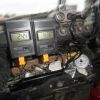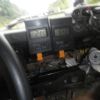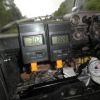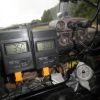-
Posts
4,949 -
Joined
-
Last visited
-
Days Won
46
Content Type
Profiles
Forums
Events
Gallery
Blogs
Posts posted by Daan
-
-
I run a 88" rr propshaft at the back, and a def 90 rr propshaft at the front, both unaltered. My wheelbase is 89" though.
-
maybe check the tow? if it tows out it can do what you discribe. Also, does it have a steering damper?
-
The workshop away from home thing, as mentioned before, is a total pita. It took me 4 years to build my car as mentioned above. So garage at home is vital. One problem you will find is that your landy is too tall to fit the average UK garage. I used to fit bare rims to the rear axle to get mine in. This is also a pain, so at least take a tape measure if youre viewing a house with a garage, and at least have a contingency plan if the garage is too low.
Daan
-
I think the issue with hutchinson wheels is mainly that they cost a fortune and weigh a ton, before you realise they are a bit vissually challenged.
The portal conversion only allows 35" tyres to be used, and still don't last. That said, it is a good looking truck!
Daan
-
neat job on the wings. Is there any connection to the grille panel, or are they 'free standing'?
-
Daan,
How did you mount the thermocouples to read i/c inlet and outlet temps, please?
Mike
Mike, I just pulled the hose off, and push it back on with thermocouple wire in it, do up the clamp. works ok, especially with silicon hoses
Can't say I have read the thread, however I have a friend who has a 200tdi in a series 3 without an intercooler and has been running it for around 60'000 miles with no issues. When he put it in he reduced the pressure to 0.7Bar as he didn't need the power and just wanted a reliable engine with a easy engine bay layout. He is more than happy with it.
So seeing that the 200 and 300 are essentially the same I don't see any reason why you cannot do it. You'll lose a chunk of power and some cooling across the inlet valves (never heard of any problems with a TDI valve) but that's it.
Your friend may be happy with it, but the engine is down tuned by reducing the amount of air going in; this is not desirable in my opinion. I would say, leave the intercooler and turbo untouched, but just reduce the amount of fuel going in, and the turbo pressure etc will come down with it. This way, you are sure you have down tuned by increasing the efficiency. Just my 2p.
This is a rather overlooked point - even with zero airflow from a fan or forward movement, an intercooler is still a huge surface area of heat exchanger mounted in free air in front of your truck.
the idea that an intercooler is a heatsink is absolutely minimal; the thermal mass of very thin aluminium with air inside is almost nothing. I should really post a video of the readouts, because the speed of the intercooler temp changes are amazingly fast; on my post up the uphill acceleration from 30 to 80 is in about 20 secs, and you can see that the intercooler follows within split seconds of the turbo. Also if no air is forced through it, the surface area is similar to a radiator filled with mud; there is virtually no cooling.
It's all interesting discussion though, i posted the question because i worried the engine might suffer without one but so far the only thing we all seem to agree on is that performance suffers. In my application i'm not too bothered about having max performance because the vehicle was never designed to be fast. Based on everything i've read in these responses and the accounts from people who are actually running tdi's without intercoolers, i think i'll run without one at first and if i feel it would benefit from the intercooler i can always add it later. The responses have helped to put my mind at rest though so thanks to everyone that has responded.
Well, my opinion, and I have given you facts, which prove that you average a 50 deg temp drop, prove in my mind that removing the intercooler is a very bad thing to do to your engine. No, it wont blow up, but it just is a lot happier, whether you use full power or just trundle along.
This I found on the internet:
12.0 psi = .83 bars
12.5 psi = .86 bars
15 psi = 1.03 bars
That is interesting, as 15 psi is exactly what I get on my engine. I bought the engine new crated, as a repower unit for early defenders, and I haven't touched any of the settings. most people that drove it have commented though that it goes incredibly well.
Daan
-
-
I still reckon there is another problem somewhere that just hasn't been identified -I can't see why my 4.0 putting out ~240-250BHP should be putting out so much less heat than a 5.2 putting out 330BHP.
The power output is 32% more, and therefore your cooling requirement is 32% more. Its an old fashioned petrol engine, so 1/3rd goes to mechanical power, 1/3rd to the exhaust, and 1/3rd to cooling. any increase to power, will also mean the same increase in heat.
Anyway, tidy job on the louvres!
Daan
-
Damit, these have come down in price, I swear I paid £12 each for them:
Don't let the price put you of, I tried it with a boiling kettle, and it was pretty much bang on 100 deg. C.
Daan
-
would be interested to understand what happens at crawling speed?
also do you have a fan?
an EGT gauge would be useful too to tranlate the actual manifold inlet temp to exhaust temp?
top work, im glad someone has got round to doing the test, as i would love to but dont have the time or the equipment (well work wouldnt allow me to use it for my own project anyway)
Do those readouts datalog too? some graphage would be ace!
At crawling speed, on tickover, not so much happens, as the turbo does not much. the temp drop is 5-10 degrees, as the charge still warms up through the turbo, and than gets cooled down in the intercooler.
Anything higher than tickover, the intercooler is very good to have, with the viscous fan and cowling. removal of fan immediately increased temps by 10 degrees while going offroad. On road, removal of the fan increases the temps by about 5 degrees
EGT I never measured, I imagine it to be a linear relationship with the inlet charge temp (an assumption!). Maybe someone else could test this? The reason I never spend time on EGT is that I have a standard setup. If you run heavily modded (high boost etc.), EGT can be usefull to know whether the turbine is about to get roasted or has already roasted. Neither of which I have any interest (or worry) in getting near to.
There is no data logging option on the readouts, but if you go to the effort of this, I presume you can plug in the thermo couples directly in your logger.
On turbo intercooler projects that I worked on professionally, The only thing that really mattered is temperature and boost in the inlet manifold. Most analysis and testing gets always done at the lower speeds (as in accelerating out of a corner), were as at high speed, things are usually ok naturally, due to the air speed.
For us, this is even more important, because the speeds we do offroad are much lower still.
Nice one Daan, quite sad as you say that there's pages and pages of opinions but so far you're the only person who's gone and measured something and posted up some actual factual data.
You may need to borrow this:
I'm sure the team of engineers at Land Rover just did whatever their mate down the pub said would work


-
I'd add a cover to stop branches getting caught, or it coming off. I dont think a proper setup will come off easily, as mentioned with the motorbike comparison, just peace of mind.
Daan
-
out of curiosity, did you notice what the temps were at idle after the run? do they drop down to near ambient?
Yes, very close to ambient.
Daan
-
I dont bother with car salesman anymore. I bought my last car at auction. Thats were the sales guys are going. I wrote down regs and end prices of the cars that I offered on and didn't get. Then spend the next month or so looking at autotrader to see if they appeared. 2 of them did and were up for the auction end price + £1750. Most salesman are pretty slick with whats on their forecourt, with the internet these days everybody knows what everybody asks, so it can never be miles off.
It only works if a car has been standing for a year or longer and they cant stand the sight of it anymore. But if it is a decent defender that won't happen.
-
Yet another page of opinions, great reading!
As no one took up my invitation to measure whats going on, I supposed I just have to do it myself....
So here we go, driving my truck to work today, I decided to rig up my camera and get an inside view of what an intercooler does:
Driving to work involves a bit of A34 past oxford, then go up hinksey hill from a standing start, modest gradient.First, cruising @ 50 mph on the A34:Cruising @ 70:Accelerating from a red light, up hinksey hill.Flat out @ 30 MPH:Flat out @ 50 MPH:Flat out @ 70 MPH:And the last, just because I could, flat out @ 80 MPHThe temperature on the right represents intercooler temp in, the temperature on the left represents intercooler temp out.
On the right you can also see boost, measured in the inlet manifold.
I measured a good 60 degrees temp drop flat out at 80 MPH, and 40 degrees tempdrop at 30 MPH.
The intercooler used has a standard core, but slightly rerouted pipes. Standard cowling is fitted, and using the standard viscous fan.
Turbo is standard, boost as per factory.
Pump standard, with standard fuel delivery as per factory.
I waited for the right moment when there was almost no traffic, at around 7 am this morning.
Ambient temp when I left home was 14 deg c.
Daan
-
I dont think it needs the shut off valve; you can just disconnect the tyre valve from your line if need be. You are going to have to be able to disconnect it anyway, if you swap a wheel. so in case the system is down, disconnect all wheels, put valve bodys in the valves. you would probably have to have a seperate pump (ARB pump) to then pump them all up, because if your main pump has failed....
Daan
-
-
My daily commute serie 2a sits on 255x85x16 and I find the steering very light.
Not heavier than the 235x85x16 I had before.
I used to own a 110 without PAS and that had definitely heavier steering.
Eric.
I presume these are mud terrains? I had this experience also, the profile blocks just bend when you steer, rather than drag like a roadgoing tyre.
I also find that a larger offset (as in wider track) actually helps, as the wheel will roll over the road, rather than drag.
One mod I did to my series 3 was to fit grease nipples to the upper swivel pin. This drastically reduced the steering effort. Also top up the idler bearing unit with oil occasionally.
Daan
-
I used midwest control for my freespool actuation very recently:
Pleased with their quality, but they are american. There are uk distributors, but not quite setup to produce cables just yet.
https://www.midwestcontrol.com/
Daan
-
They use it in russia quite a bit. I suppose if you go rock crawling only, you just set the tyre pressure and run. But if you do rockcrawling or swampdriving one moment, than flat out the next, its perfect. It is quite complicated though, and the seals can fail (like an ARB air feed seal). I do remember a famous picture from ladoga of a car arriving at the finish with 4 flat tyres, due to a failure of the CTIS. I think they remove the valve internals to make pumping up and down go quicker, but then if there is a failure...oh dear. I would love CTIS, but I would have a good think about the failure modes, and the contingency plan.
-
Ceramic coating the exhaust manifolds stop it getting so hot in first place ?
Thats a good call.
I run a lhd s3 rh wing, and a rhd s3 lh wing, so have the vent holes in both of them (no heater installed). That works, but the change that worked best for this problem is to remove the inner wheelarches, if you haven't done so already.
The trouble with anything in bonnet is that it serves to end up in the cabin when the venting flaps are open, so I have always tried to avoid it.
-
loosen off the shackle bolts, then drive it around for a bit and retighten might help. As mentioned the friction could be bigger due to rust. I think the parabolics have nylon slider blocks, but still worth checking.
-
I ran 109 station wagon sides on my 88".
Daan
-
DD is a bit busy scrutineering on KOV (aparently not making friends as he failed quite a few cars). Still, his head will grow twice the size when he reads all this.
Keep it going mate!
Daan
-
 1
1
-
-
the roll centre is only there at right height while driving in a straight line. The moment it does start leaning in corners, it starts moving around, on a panhard rod especially. A wattslinkage is better for this, as the roll centre is an actual pivot axis.
Daan










LT77 / Series adaptation
in International Forum
Posted
Yes, just lazy...